Yuqian Yuan
EOC-Bench: Can MLLMs Identify, Recall, and Forecast Objects in an Egocentric World?
Jun 05, 2025Abstract:The emergence of multimodal large language models (MLLMs) has driven breakthroughs in egocentric vision applications. These applications necessitate persistent, context-aware understanding of objects, as users interact with tools in dynamic and cluttered environments. However, existing embodied benchmarks primarily focus on static scene exploration, emphasizing object's appearance and spatial attributes while neglecting the assessment of dynamic changes arising from users' interactions. To address this gap, we introduce EOC-Bench, an innovative benchmark designed to systematically evaluate object-centric embodied cognition in dynamic egocentric scenarios. Specially, EOC-Bench features 3,277 meticulously annotated QA pairs categorized into three temporal categories: Past, Present, and Future, covering 11 fine-grained evaluation dimensions and 3 visual object referencing types. To ensure thorough assessment, we develop a mixed-format human-in-the-loop annotation framework with four types of questions and design a novel multi-scale temporal accuracy metric for open-ended temporal evaluation. Based on EOC-Bench, we conduct comprehensive evaluations of various proprietary, open-source, and object-level MLLMs. EOC-Bench serves as a crucial tool for advancing the embodied object cognitive capabilities of MLLMs, establishing a robust foundation for developing reliable core models for embodied systems.
ECBench: Can Multi-modal Foundation Models Understand the Egocentric World? A Holistic Embodied Cognition Benchmark
Jan 09, 2025



Abstract:The enhancement of generalization in robots by large vision-language models (LVLMs) is increasingly evident. Therefore, the embodied cognitive abilities of LVLMs based on egocentric videos are of great interest. However, current datasets for embodied video question answering lack comprehensive and systematic evaluation frameworks. Critical embodied cognitive issues, such as robotic self-cognition, dynamic scene perception, and hallucination, are rarely addressed. To tackle these challenges, we propose ECBench, a high-quality benchmark designed to systematically evaluate the embodied cognitive abilities of LVLMs. ECBench features a diverse range of scene video sources, open and varied question formats, and 30 dimensions of embodied cognition. To ensure quality, balance, and high visual dependence, ECBench uses class-independent meticulous human annotation and multi-round question screening strategies. Additionally, we introduce ECEval, a comprehensive evaluation system that ensures the fairness and rationality of the indicators. Utilizing ECBench, we conduct extensive evaluations of proprietary, open-source, and task-specific LVLMs. ECBench is pivotal in advancing the embodied cognitive capabilities of LVLMs, laying a solid foundation for developing reliable core models for embodied agents. All data and code are available at https://github.com/Rh-Dang/ECBench.
VideoRefer Suite: Advancing Spatial-Temporal Object Understanding with Video LLM
Jan 08, 2025Abstract:Video Large Language Models (Video LLMs) have recently exhibited remarkable capabilities in general video understanding. However, they mainly focus on holistic comprehension and struggle with capturing fine-grained spatial and temporal details. Besides, the lack of high-quality object-level video instruction data and a comprehensive benchmark further hinders their advancements. To tackle these challenges, we introduce the VideoRefer Suite to empower Video LLM for finer-level spatial-temporal video understanding, i.e., enabling perception and reasoning on any objects throughout the video. Specially, we thoroughly develop VideoRefer Suite across three essential aspects: dataset, model, and benchmark. Firstly, we introduce a multi-agent data engine to meticulously curate a large-scale, high-quality object-level video instruction dataset, termed VideoRefer-700K. Next, we present the VideoRefer model, which equips a versatile spatial-temporal object encoder to capture precise regional and sequential representations. Finally, we meticulously create a VideoRefer-Bench to comprehensively assess the spatial-temporal understanding capability of a Video LLM, evaluating it across various aspects. Extensive experiments and analyses demonstrate that our VideoRefer model not only achieves promising performance on video referring benchmarks but also facilitates general video understanding capabilities.
Chain of Ideas: Revolutionizing Research Via Novel Idea Development with LLM Agents
Oct 25, 2024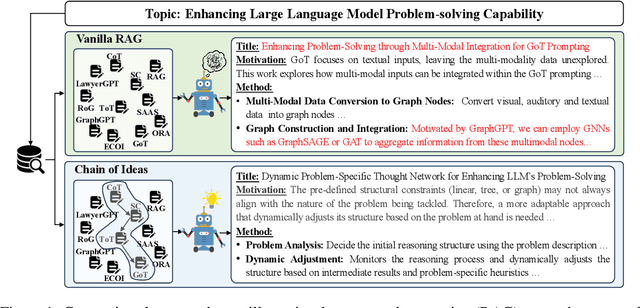

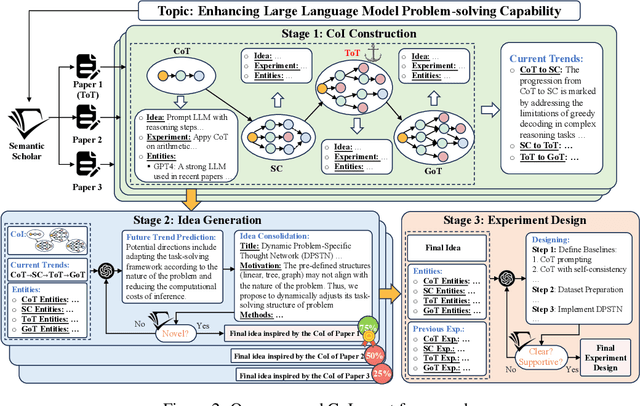

Abstract:Effective research ideation is a critical step for scientific research. However, the exponential increase in scientific literature makes it challenging for researchers to stay current with recent advances and identify meaningful research directions. Recent developments in large language models~(LLMs) suggest a promising avenue for automating the generation of novel research ideas. However, existing methods for idea generation either trivially prompt LLMs or directly expose LLMs to extensive literature without indicating useful information. Inspired by the research process of human researchers, we propose a Chain-of-Ideas~(CoI) agent, an LLM-based agent that organizes relevant literature in a chain structure to effectively mirror the progressive development in a research domain. This organization facilitates LLMs to capture the current advancements in research, thereby enhancing their ideation capabilities. Furthermore, we propose Idea Arena, an evaluation protocol that can comprehensively evaluate idea generation methods from different perspectives, aligning closely with the preferences of human researchers. Experimental results indicate that the CoI agent consistently outperforms other methods and shows comparable quality as humans in research idea generation. Moreover, our CoI agent is budget-friendly, with a minimum cost of \$0.50 to generate a candidate idea and its corresponding experimental design.
Chain of Ideas: Revolutionizing Research in Novel Idea Development with LLM Agents
Oct 17, 2024



Abstract:Effective research ideation is a critical step for scientific research. However, the exponential increase in scientific literature makes it challenging for researchers to stay current with recent advances and identify meaningful research directions. Recent developments in large language models~(LLMs) suggest a promising avenue for automating the generation of novel research ideas. However, existing methods for idea generation either trivially prompt LLMs or directly expose LLMs to extensive literature without indicating useful information. Inspired by the research process of human researchers, we propose a Chain-of-Ideas~(CoI) agent, an LLM-based agent that organizes relevant literature in a chain structure to effectively mirror the progressive development in a research domain. This organization facilitates LLMs to capture the current advancements in research, thereby enhancing their ideation capabilities. Furthermore, we propose Idea Arena, an evaluation protocol that can comprehensively evaluate idea generation methods from different perspectives, aligning closely with the preferences of human researchers. Experimental results indicate that the CoI agent consistently outperforms other methods and shows comparable quality as humans in research idea generation. Moreover, our CoI agent is budget-friendly, with a minimum cost of \$0.50 to generate a candidate idea and its corresponding experimental design.
TokenPacker: Efficient Visual Projector for Multimodal LLM
Jul 02, 2024
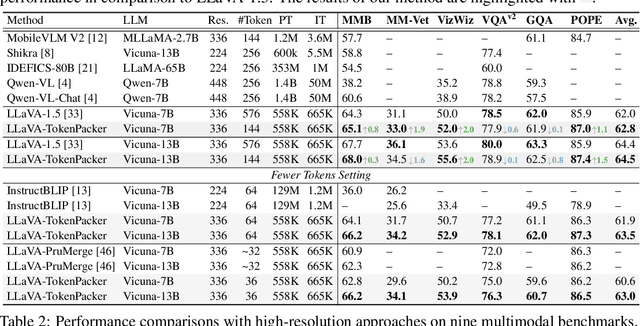
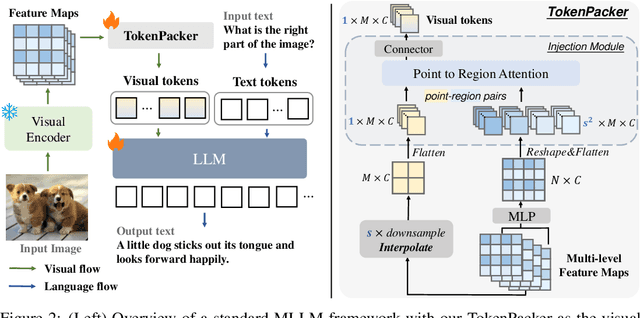
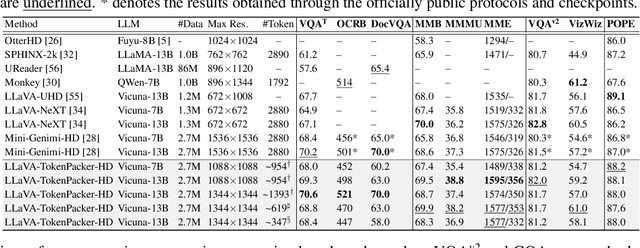
Abstract:The visual projector serves as an essential bridge between the visual encoder and the Large Language Model (LLM) in a Multimodal LLM (MLLM). Typically, MLLMs adopt a simple MLP to preserve all visual contexts via one-to-one transformation. However, the visual tokens are redundant and can be considerably increased when dealing with high-resolution images, impairing the efficiency of MLLMs significantly. Some recent works have introduced resampler or abstractor to reduce the number of resulting visual tokens. Unfortunately, they fail to capture finer details and undermine the visual reasoning capabilities of MLLMs. In this work, we propose a novel visual projector, which adopts a coarse-to-fine scheme to inject the enriched characteristics to generate the condensed visual tokens. In specific, we first interpolate the visual features as a low-resolution point query, providing the overall visual representation as the foundation. Then, we introduce a region-to-point injection module that utilizes high-resolution, multi-level region-based cues as fine-grained reference keys and values, allowing them to be fully absorbed within the corresponding local context region. This step effectively updates the coarse point query, transforming it into an enriched one for the subsequent LLM reasoning. Extensive experiments demonstrate that our approach compresses the visual tokens by 75%~89%, while achieves comparable or even better performance across diverse benchmarks with significantly higher efficiency. The source codes can be found at https://github.com/CircleRadon/TokenPacker.
Osprey: Pixel Understanding with Visual Instruction Tuning
Dec 25, 2023Abstract:Multimodal large language models (MLLMs) have recently achieved impressive general-purpose vision-language capabilities through visual instruction tuning. However, current MLLMs primarily focus on image-level or box-level understanding, falling short of achieving fine-grained vision-language alignment at the pixel level. Besides, the lack of mask-based instruction data limits their advancements. In this paper, we propose Osprey, a mask-text instruction tuning approach, to extend MLLMs by incorporating fine-grained mask regions into language instruction, aiming at achieving pixel-wise visual understanding. To achieve this goal, we first meticulously curate a mask-based region-text dataset with 724K samples, and then design a vision-language model by injecting pixel-level representation into LLM. Especially, Osprey adopts a convolutional CLIP backbone as the vision encoder and employs a mask-aware visual extractor to extract precise visual mask features from high resolution input. Experimental results demonstrate Osprey's superiority in various region understanding tasks, showcasing its new capability for pixel-level instruction tuning. In particular, Osprey can be integrated with Segment Anything Model (SAM) seamlessly to obtain multi-granularity semantics. The source code, dataset and demo can be found at https://github.com/CircleRadon/Osprey.
Label-efficient Segmentation via Affinity Propagation
Oct 17, 2023



Abstract:Weakly-supervised segmentation with label-efficient sparse annotations has attracted increasing research attention to reduce the cost of laborious pixel-wise labeling process, while the pairwise affinity modeling techniques play an essential role in this task. Most of the existing approaches focus on using the local appearance kernel to model the neighboring pairwise potentials. However, such a local operation fails to capture the long-range dependencies and ignores the topology of objects. In this work, we formulate the affinity modeling as an affinity propagation process, and propose a local and a global pairwise affinity terms to generate accurate soft pseudo labels. An efficient algorithm is also developed to reduce significantly the computational cost. The proposed approach can be conveniently plugged into existing segmentation networks. Experiments on three typical label-efficient segmentation tasks, i.e. box-supervised instance segmentation, point/scribble-supervised semantic segmentation and CLIP-guided semantic segmentation, demonstrate the superior performance of the proposed approach.
Point2Mask: Point-supervised Panoptic Segmentation via Optimal Transport
Aug 03, 2023



Abstract:Weakly-supervised image segmentation has recently attracted increasing research attentions, aiming to avoid the expensive pixel-wise labeling. In this paper, we present an effective method, namely Point2Mask, to achieve high-quality panoptic prediction using only a single random point annotation per target for training. Specifically, we formulate the panoptic pseudo-mask generation as an Optimal Transport (OT) problem, where each ground-truth (gt) point label and pixel sample are defined as the label supplier and consumer, respectively. The transportation cost is calculated by the introduced task-oriented maps, which focus on the category-wise and instance-wise differences among the various thing and stuff targets. Furthermore, a centroid-based scheme is proposed to set the accurate unit number for each gt point supplier. Hence, the pseudo-mask generation is converted into finding the optimal transport plan at a globally minimal transportation cost, which can be solved via the Sinkhorn-Knopp Iteration. Experimental results on Pascal VOC and COCO demonstrate the promising performance of our proposed Point2Mask approach to point-supervised panoptic segmentation. Source code is available at: https://github.com/LiWentomng/Point2Mask.
 Add to Chrome
Add to Chrome Add to Firefox
Add to Firefox Add to Edge
Add to Edge